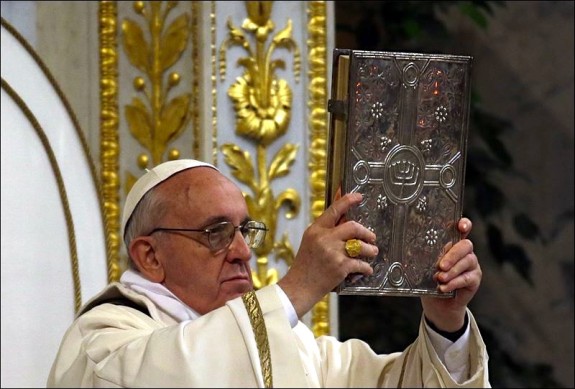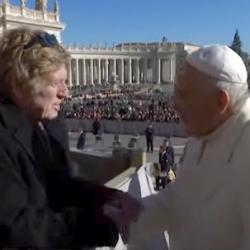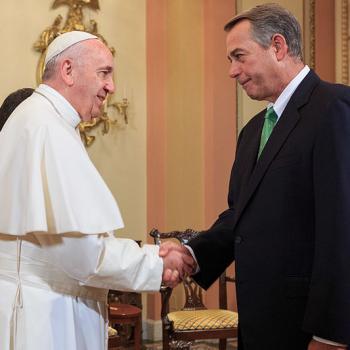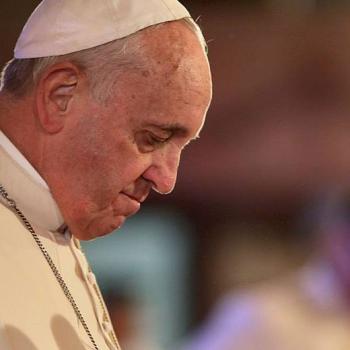From Vatican Radio:
“The Joy of the Gospel” is the title Pope Francis has chosen for this first major document of his pontificate, putting down in print the joyous spirit of encounter with Christ that characterizes every public appearance he has made so far. The man who has constantly kept the media’s attention with his desire to embrace and share his faith with everyone he meets, now urges usto do exactly the same. To “recover the original freshness of the Gospel”, as he puts it, through a thorough renewal of the Church’s structures and vision. Including what he calls “a conversion of the papacy” to make it better able to serve the mission of evangelization in the modern world. The Church, he says, should not be afraid to re-examine “customs not directly connected to the heart of the Gospel” even if they may have deep historical roots.
In strikingly direct and personal language, the Pope appeals to all Christians to bring about a “revolution of tenderness” by opening their hearts each day to God’s unfailing love and forgiveness. The great danger in today’s consumer society, he says, is “the desolation and anguish” that comes from a “covetous heart, the feverish pursuit of frivolous pleasures, and a blunted conscience.” Whenever our interior life becomes caught up in its own interests , he warns, “there is no longer room for others, no place for the poor.”As we open our hearts, the Pope goes on, so the doors of our churches must always be open and the sacraments available to all. The Eucharist, he says pointedly, “is not a prize for the perfect, but a powerful medicine and nourishment for the weak” And he repeats his ideal of a Church that is “bruised, hurting and dirty because it has been out on the streets” rather than a Church that is caught up in a slavish preoccupation with liturgy and doctrine, procedure and prestige. “God save us,” he exclaims, “from a worldly Church with superficial spiritual and pastoral trappings!” Urging a greater role for the laity, the Pope warns of “excessive clericalism” and calls for “a more incisive female presence in the Church”, especially “where important decisions are made.”
Looking beyond the Church, Pope Francis denounces the current economic system as “unjust at its root”, based on a tyranny of the marketplace, in which financial speculation, widespread corruption and tax evasion reign supreme. He also denounces attacks on religious freedom and new persecutions directed against Christians. Noting that secularization has eroded ethical values, producing a sense of disorientation and superficiality, the Pope highlights the importance of marriage and stable family relationships. Returning to his vision of a Church that is poor and for the poor, the Pope urges us to pay particular attention to those on the margins of society, including the homeless, the addicted, refugees, indigenous peoples, the elderly, migrants, victims of trafficking and unborn children. While it is not “progressive” to try to resolve problems by eliminating a human life, he says, it’s also true that “we have done little to adequately accompany women in very difficult situations, where abortion appears as a quick solution to their profound anguish.”
You can read the entire document at the Vatican website.
Glancing over the document—I haven’t read it in full yet—I was struck by a long passage on preaching, which even offers practical homiletic advice:
156. Some people think they can be good preachers because they know what ought to be said, but they pay no attention to how it should be said, that is, the concrete way of constructing a sermon. They complain when people do not listen to or appreciate them, but perhaps they have never taken the trouble to find the proper way of presenting their message. Let us remember that “the obvious importance of the content of evangelization must not overshadow the importance of its ways and means”.
Concern for the way we preach is likewise a profoundly spiritual concern. It entails responding to the love of God by putting all our talents and creativity at the service of the mission which he has given us; at the same time, it shows a fine, active love of neighbour by refusing to offer others a product of poor quality. In the Bible, for example, we can find advice on how to prepare a homily so as to best to reach people: “Speak concisely, say much in few words” (Sir 32:8).
157. Simply using a few examples, let us recall some practical resources which can enrich our preaching and make it more attractive. One of the most important things is to learn how to use images in preaching, how to appeal to imagery. Sometimes examples are used to clarify a certain point, but these examples usually appeal only to the mind; images, on the other hand, help people better to appreciate and accept the message we wish to communicate. An attractive image makes the message seem familiar, close to home, practical and related to everyday life. A successful image can make people savour the message, awaken a desire and move the will towards the Gospel. A good homily, an old teacher once told me, should have “an idea, a sentiment, an image.”
158. Paul VI said that “the faithful… expect much from preaching, and will greatly benefit from it, provided that it is simple, clear, direct, well-adapted”.[125] Simplicity has to do with the language we use. It must be one that people understand, lest we risk speaking to a void. Preachers often use words learned during their studies and in specialized settings which are not part of the ordinary language of their hearers. These are words that are suitable in theology or catechesis, but whose meaning is incomprehensible to the majority of Christians. The greatest risk for a preacher is that he becomes so accustomed to his own language that he thinks that everyone else naturally understands and uses it. If we wish to adapt to people’s language and to reach them with God’s word, we need to share in their lives and pay loving attention to them. Simplicity and clarity are two different things. Our language may be simple but our preaching not very clear. It can end up being incomprehensible because it is disorganized, lacks logical progression or tries to deal with too many things at one time. We need to ensure, then, that the homily has thematic unity, clear order and correlation between sentences, so that people can follow the preacher easily and grasp his line of argument.
159. Another feature of a good homily is that it is positive. It is not so much concerned with pointing out what shouldn’t be done, but with suggesting what we can do better. In any case, if it does draw attention to something negative, it will also attempt to point to a positive and attractive value, lest it remain mired in complaints, laments, criticisms and reproaches. Positive preaching always offers hope, points to the future, does not leave us trapped in negativity. How good it is when priests, deacons and the laity gather periodically to discover resources which can make preaching more attractive!












